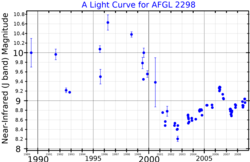AFGL 2298
| Observation data J2000
| |
|---|---|
| Constellation | Aquila |
| Right ascension | 19h 00m 10.89s[2] |
| Declination | +03° 45′ 47.1″[2] |
| Characteristics | |
| Spectral type | B8I,[3] B:I:[e],[4] B0-0.5I[5] |
| Apparent magnitude (J) | 12.164[2] |
| Apparent magnitude (H) | 8.918[2] |
| Apparent magnitude (K) | 6.91[6] |
| Variable type | LBV[4] |
| Absolute bolometric magnitude (Mbol) | −11.25[1] |
| Details | |
| Radius | 158 - 385[1] R☉ |
| Luminosity | 1,300,000 - 2,000,000[1] L☉ |
| Temperature | 11,000 - 15,500[1] or 26,000[5] K |
| Database references | |
| SIMBAD | data |
AFGL 2298, also known as IRAS 18576+0341, is a
interstellar extinction, so its apparent magnitude is brighter for longer-wavelength passbands; in fact, in visual wavelengths it is completely undetectable.[7]
AFGL 2298 has an
bolometric magnitude of −11.25,[1] making it one of the most luminous stars known. Indeed, many of the hottest and most luminous stars known are luminous blue variables and other early-type stars. However, like all LBVs, AFGL 2298 is highly variable and the bolometric magnitude refers to its peak luminosity.[1] Its status as an LBV was confirmed in 2003.[4]
Like most extremely massive stars, AFGL 2298 is undergoing mass loss.[5] For example, in 2005 it was estimated to be losing 3.7×10−5 solar masses each year,[5] although the rate of mass loss itself varies frequently and dramatically.[1] The stellar mass is currently being ejected as a nebula around the star (similar to AG Carinae), which was imaged by the Very Large Telescope in 2010.[8] The nebula was found to be fairly circular, and the properties of the dust appeared to be constant throughout the entire nebula.[8]
| Effective temperature (K) | Mass loss rate (M☉/yr) | Bolometric luminosity (L☉) | |
|---|---|---|---|
| June 2001 | 11,700 | 4.5×10−5 | 1.5×106 |
| August 2002 | 10,900 | 1.2×10−4 | 1.3×106 |
| June 2006 | 10,300 | 5.2×10−5 | 2.0×106 |
| May 2007 | 10,900 | 4×10−5 | 1.5×106 |
See also
References
- ^ S2CID 119187994.
- ^ Bibcode:2003yCat.2246....0C.
- S2CID 119427413.
- ^ .
- ^ .
- Bibcode:2006IBVS.5721....1K.
- ^ a b "AFGL 2298". SIMBAD. Centre de données astronomiques de Strasbourg. Retrieved 26 January 2017.
- ^ S2CID 119281049.

